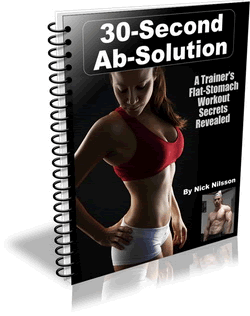There are many machines specifically designed for cardiovascular exercise.
These machines usually mimic a non-machine activity such as running (the treadmill) or skiing (the Nordic Trak ski machine).
Each works the body differently and has its pros and cons with regards to size, price, workout efficiency and skill required. Find out which one is right for you.
1. Treadmills
Treadmills are used for stationary walking or running and come in either motorized of self-powered models.
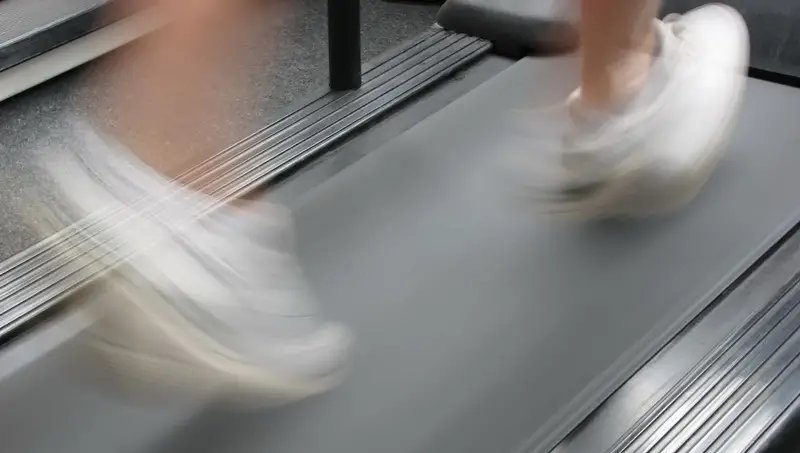
- Treadmills have been shown to burn the most calories when compared to other machines at similar intensities.
- They are very versatile. You can go fast or slow, flat or incline and sometimes decline.
- Treadmills also keep you at the same pace. This is useful for trainers who have a tendency to slow down as they tire. A motorized treadmill will keep you honest!
- Most have some sort of electronic monitoring readout on the front as well as preprogrammed routines (e.g. interval training, hills, fat loss, etc.). These are useful for watching time and intensity as well as for varying your workouts.
- All in all, the treadmill is an excellent machine to do cardio work on.
The Problem With the Treadmill
The motorized treadmill does have a biomechanical problem to it, though, that is not immediately obvious.
- Since the tread goes backwards by itself, there is no forward-pushing force needed from the muscles, unlike ground walking where if you don't push forward, you don't go anywhere.
- Much of the work done on a treadmill is done when you bring your leg forward. This can overwork your hip flexors and underwork your glutes.
- Many runners find that if they train too much on a treadmill, their hip flexors become very tight and can cramp up on long runs on regular ground. Their hip flexors may also become very strong and well developed at the expense of their quads of glutes.
The Solution
There are several ways you can remedy this problem.
- Consciously push back against the track as you walk or run, as though constantly trying to accelerate. Do not just passively allow the track to bring your leg backwards - push yourself forward. This alleviates the problem and has the added bonus of burning more calories by using more muscle mass.
- Avoid exercises that overstress the hip flexors. As well, sitting all day can aggravate tight hip flexors by putting them in a shortened position all day.
- Be sure to stretch your hip flexors after every treadmill session.
Buying A Treadmill
There are a number of things you should look for when you are buying a treadmill.
-
Look for high continuous horsepower not peak horsepower. This will maximize long-term use.
-
You should look for a treadmill with some give in the deck to cushion your body when you run. This will reduce the impact on your body.
-
Another good feature to have is a reversible deck (the actual tread of the treadmill where you walk or run on). This will save money as once one side wears out, you can just change the side.
-
An emergency stop button is also a very good feature. Some treadmills have clips that you attach to yourself that trigger an emergency stop if they get tugged too far (e.g. when you are slipping off the back or if you fall).
-
If you wish to buy a foldable unit, be aware that they sacrifice stability for this feature.
Treadmill Safety Guidelines
- Stand on the sides, not the belt when you start the machine.
- Gauge the speed before stepping on.
- Hold the handrails when you first get on.
- Take a few moments to get used to the treadmill feel.
- Always look forward, never behind or to the sides. This throws your balance off. Hold the rail if you must talk.
- If you lose your balance, grab the rails and step off to the side.
- Change your speed gradually.
- When you hit the “Stop” button, keep walking until it actually stops. There is a few seconds lag time.
- Try to stay in the center of the belt.
- Make sure your shoelaces are tied.
- Don’t lean on the rails. Use them for balance only.
Treadmill Reviews
If you're interested in purchasing a treadmill, I would recommend checking out this page on treadmill reviews. They've put together an excellent, comprehensive comparison of many of the top brands and their offerings, whether it's for walking, running or more intense athletic training.
2. Stair Machine
The stair machine mimics the action of climbing stairs with varying degrees of success. There are a number of different stair climbers available.

- The first and worst are the little hydraulic floor models that have a four inch range of motion with one pedal being pushed up as the other goes down. Don't bother with these ones.
- The next is the larger, health-club version with the same mechanics of one pedal going up as the other goes down. This is somewhat better as the range of motion is greater. The best version has independently moving pedals. This better simulates actual stair climbing because you must actually raise your leg instead of having the machine force it back up for you.
- The last type of stair machine is the treadmill type where a set of stairs continuously rotates around. This is also known as a Stepmill. This most closely approximates actual stair climbing, as you must constantly step up. Be sure to push off forcefully, otherwise you will run into the same problem as in the treadmill where the backward work is done for you.
The stair climber is a low impact machine that can be useful for all levels of fitness.
- They only apply force at about 1.2 times your bodyweight, which is comparable to walking. Actual stairs apply forces of twice your bodyweight on the way up and up to seven times on the way down.
- Stair machines are not bad for your knees. Those with back problems should be careful not to lean over excessively.
- A potential complaint about stair machines is foot numbness. This comes from continuous pressure on the feet for extended periods of time. Lift your feet off every now and then to help circulation.
- Do not lean on the rails while stepping. Many trainers tend to lock their arms and support their body on the railings at arm’s length. This decreases the effectiveness of the exercise considerably, reducing it to a short pumping motion.
What to Look For When Buying a Stair Machine
Here are some to points to consider if you are looking at purchasing a stair-machine.
- Look for one that is cable or chain driven. This will increase its longevity.
- A comfortable minimum stepping speed is an important feature for beginners or those who are not in good shape.
- It should be stable without any wobble.
- A good machine will have hinges on the pedals to allow your feet to remain horizontal while stepping. Slanting, fixed pedals can strain ankles.
3. The Stationary Bike
There are three main types of bikes: the classic bike, the bike with arm levers and the recumbent bike (reclining). Stationary cycling is exactly like real cycling but without balance or scenery. The bikes may utilize a flywheel, resistance strap or air resistance mechanism, but they all provide the same basic workout.
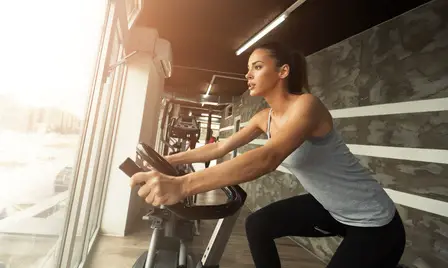
- The classic bike is just a seat, handlebars and pedals. This is what most people think of when they hear the words "stationary bike".
- The bikes with arm levers incorporate a push-pull movement to work the upper body as well.
- The recumbent bike (where you sitting back in a chair and the pedals are in front of you) is the most comfortable. This type of seat can alleviate any numbness you may experience when riding a bike with a regular seat. The recumbent bike position unblocks the hips allowing additional muscles, e.g. hamstrings and glutes, to engage. This burns more calories and takes stress off the knees by helping the quads perform the work.
Pros and Cons of the Stationary Bike
Cycling, like any activity has its advantages and disadvantages.
-
Cycling is good because it is completely non-impact, making it ideal for those carrying a lot of excess weight. There is no stress on knees or back.
-
It is convenient to do. All you need is the bike.
-
It requires almost no skill to learn.
-
Bikes can have uncomfortable seats. This can be a major issue if you plan on using the bike for long periods of time.
-
Since it only works the lower body, it doesn’t burn as many calories as an exercise that also involves the upper body. Some bikes have arm levers that address this issue.
-
It can be fairly dull as the scenery never changes. Use a book, magazine, music, television or good company to alleviate this problem.
How to Properly Set the Seat on a Stationary Bike
When you are using a bike, it is important to set the seat correctly. Here are a few pointers.
- The seat should be set at a height so that when the pedal is at the bottom you still have a slight bend in your knee. If you have to lean over each time you push, it will get uncomfortable in a hurry.
- Set the seat too low and you will not get maximum extension and therefore you will not get maximum power.
- Most seats have a pin in the back that you pull out, allowing you to raise or lower the seat.
Spinning
Group stationary cycling classes have become popular recently. This is called Spinning. It is a similar concept to aerobics classes in that you have somebody leading the group but each person is on a bike instead of just on the floor or at step platforms. The instructor systematically varies the resistance and tempo, often to music, to keep cycling from getting boring. It is similar to Fartlek (speed play) training on a bike. For those who find solo stationary biking boring, this can be a good alternative.
4. Rowing Machines
Rowing machines simulate the movement of rowing a boat. They can be either flywheel or hydraulic with a moving seat on a track.
- Rowing gives you a good, whole-body workout but can be hard on your lower back, especially if you aren’t using proper form.
- You may also find your grip giving out before you get a good workout.
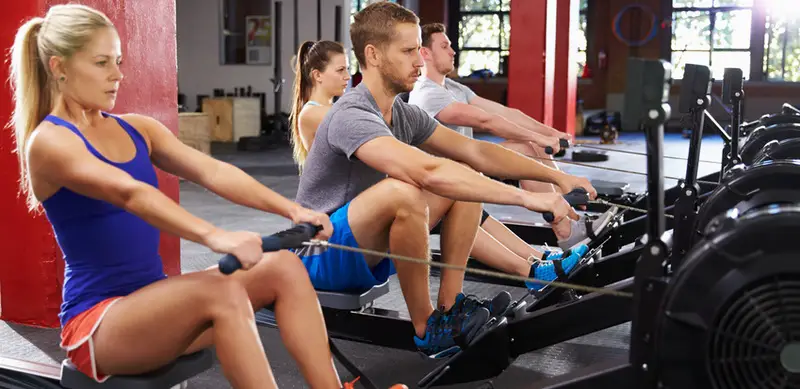
- Start the motion by pushing back with your legs, pulling back with your arms as you finish the leg push.
- When you slide forward, let your arms straighten as you bend your knees.
- Be sure to keep your lower back arched and tight throughout the movement.
- Do not lean forward excessively.
- Exhale as you pull and inhale as you go back to the starting position.
5. Skipping Ropes
This is a simple but effective piece of equipment that can lend variety to a cardio workout.
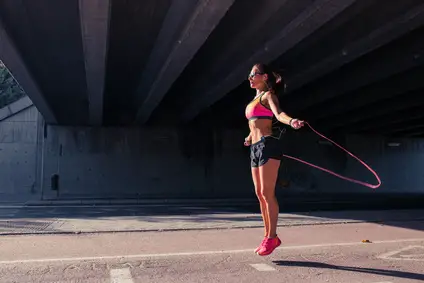
- It gives your lower body, upper body and grip work while improving your coordination.
- The heavier the rope, the more intense the workout will be.
- Variations of skipping include two leg, 1 leg (continuous), 1 leg (alternating), moving forward, moving backward, moving sideways, double turns, and crossovers.
- One of the main problems with skipping is the coordination required. In order to skip, you have to be able swing the rope and jump at the same time. Some people just can't seem to do it.
- It is also a fairly high impact activity, which means it may not be appropriate for everybody to use.
6. Ski Machines
The ski machine provides an excellent total body workout once you get the coordination right.

- Make sure you get one with independently moving foot pedals and poles on a flywheel (Nordic Track is one of the best).
- The machines with arm poles and simultaneous forward/back pedals do not provide a natural movement.
- The better machines have separate resistance controls for upper and lower body.
- Another good feature is elevation adjustment for skiing uphill.
- If you've ever cross-country skied, the machines will take some getting used to but the total-body cardio benefits make it worthwhile.
7. Elliptical Machines
These machines resemble a melding of bikes and stair machines. The pedals move in an elliptical track.
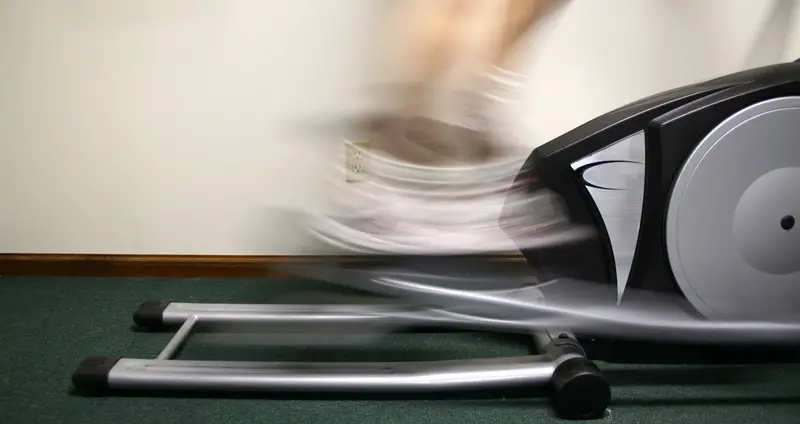
- It is a similar motion to running but without the impact.
- The movement can also be reversed to vary the effects.
- Find one that allows for natural strides as though walking, otherwise joint stress can result.
- This type of trainer provides a good, low-impact cardio workout.
A Note About Calorie Counters on Cardio Machines
The calorie counters on cardio machines measure the force being applied to the machine, not actual calories burned. The bodyweight entry is critical in determining approximate calories burned.
There are a number of factors at work that have the potential to skew the number by 10% or more. Just remember to take the number of calories burned as a rough estimate, not an exact figure.
- Skill – increased skill on the machine generally results in fewer calories burned.
- Body composition – people with more lean tissue will burn more calories.
- Gender – women will burn fewer calories due to generally higher bodyfat levels and a lower metabolic rate.
- Fitness level– those in good shape will burn fewer calories because their bodies are more efficient.
- Nutritional state – number of calories eaten and the ratio of macronutrients (fat, protein and carbohydrates) consumed.
Here are the different types of cardiovascular training you can for fitness and fat loss.
![]()
More From Fitstep.com
Share This Page...
---
Home -> Fitness For Beginners -> Cardio Fitness -> Equipment



